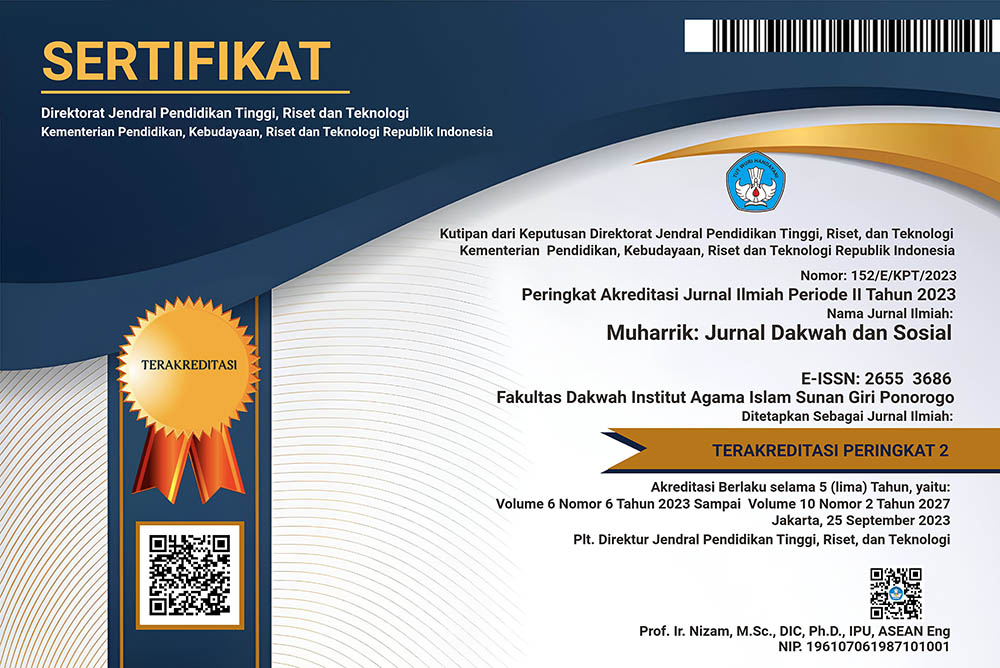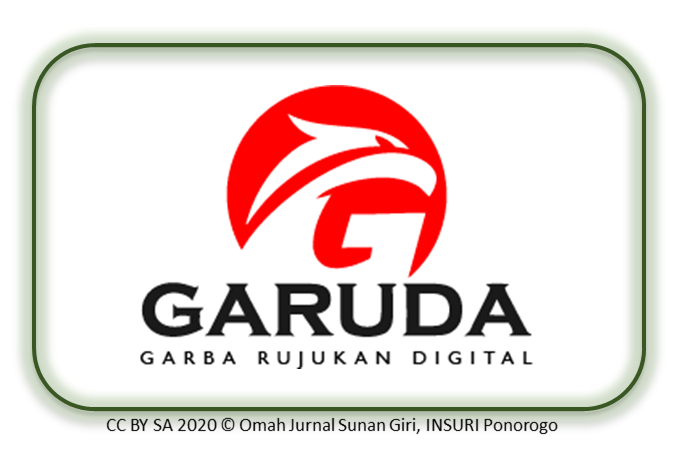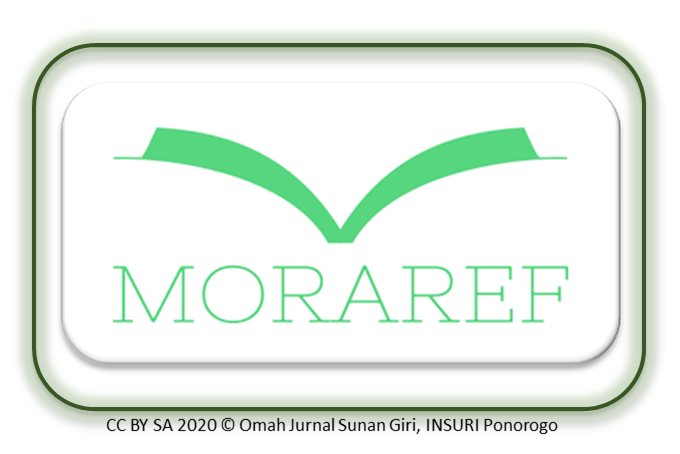Da’wah Bil Hal and Muslim Women’s Religious Humanist Ideology in Indonesian Film
Keywords:
da'wah bil hal, religious humanism, Merindu Cahaya de Amstel, John Fiske's semiotic theoryAbstract
This study aims to find out the overview of da'wah bil hal as an approach for proselytizing through actual actions or the role model from attitudes and behaviours represented in the religious film entitled "Merindu Cahaya de Amstel" by Hadrah Daeng Ratu. This research used the descriptive-analytic method to analyze the meaning of data in a movie using John Fiske's semiotic theory, which involve three levels, namely reality, including (1) appearance, costumes, environment, manner of speaking, gestures, and facial expressions; (2) representation, including, conflict, action and dialogue; and (3) ideology, the interpretations result of the fundamental level and representations categorized in social relations by ideological codes. The results showed that the da’wah bil hal approach in the movie "Merindu Cahaya de Amstel" was depicted through the appearance of the main character named Khadija, seen in her closed clothes (aurat). Besides, the way of speaking, gestures, and facial expressions revealed the personality of Muslims who are polite, helpful and have good respect for others. How Khadija's conflicts, actions, and dialogues are represented in this movie shows the characteristics of Muslims with a good character, balancing hablumminallah and hablumminannas, patience, devout worship, and always spreading usefulness. The practice of da'wah bil hal or proselytizing through the figure of Khadija, showed an ideology of religious humanism. The novelty of this research is the analysis of da’wah bil hal in a movie through the depiction of Muslim female characters applying Islamic values, including morals, trust, and worship.
References
Aminudin, A. (2018). Proselytizing the Age Now. Al-MUNZIR, 11(1).
Anggito, A, & Setiawan, J. (2018). Qualitative research methodology.
Ardianto, Y. (2019). Understand qualitative research methods. In Djkn (Issue 2).
Bahtiar, A. T., Ghazali, B., Nasution, Y. Y., Shonhaji, S., & Yanti, F. (2020). Dakwah Bil Hal: Empowering Muslim Economy in Garut. The Science of Da'wah: Academic Journal for Homiletic Studies, 14(1). https://doi.org/10.15575/idajhs.v14i1.9122
Sunarso, B. (2021). Dakwah Bil Hal as a Method of Dakwah in Society Muneng Ledokdawan Village, Grobogan Regency. Journal of Research and Multidisciplinary Vol. 4 No. 2, 493-494.
Christianto, F. V, Tjahyana, L. J., & ... (2020). Representations of Pluralism in Ngenest Films. Jurnal E-Communications.
Fadli, R. V. (2020). REVIEW OF THE PHILOSOPHY OF HUMANISM: A STUDY OF PAULO FREIRE'S THOUGHT IN EDUCATION. JOURNAL REFORMA, 9(2). https://doi.org/10.30736/rf.v9i2.317
Firdaus, M. (2017). FISHERIES RESOURCE MANAGEMENT IN REGULATORY CONSTRUCTION IN INDONESIA. Scientific Bulletin of Marine and Fisheries Socioeconomic Marina, 2(1). https://doi.org/10.15578/marina.v2i1.3280
Judge, R. (2017). Dakwah Bil Hal: Implementing Amanah Values in Zakat Management Organizations to Reduce Inequality and Poverty. IQTISHODIA: Journal of Islamic Economics, 02(02).
Hasanah, R. (2020). CHARACTER EDUCATION IN THE QURANIC PERSPECTIVE OF RAFIATUL HADITH. HOLISTIC : PGSD Scientific Journal, Volume IV(1).
Helmiannoor, H., & Musyarapah, M. (2019). The Existence and Dedication of Women Scholars towards Islamic Education in the Archipelago. SHAMYL: Journal of Islamic Education, 7(2). https://doi.org/10.21093/sy.v7i2.1782
Kholis, N., Mudhofi, M., Hamid, N., & Aroyandini, E. N. (2021). Da'wah Bil-Hal Kiai as an Effort toEmpower Santri. Journal of Da'wah Treatises, 32(1).
Kristiyono, J. (2017). Film as a Medium of Tourism Communication. Tourism, Hospitality and Culinary Journal Vol. 2 No. 1, 2.
Muawwanah, S., & Darmiyanti, A. (2022). Internalization of Islamic Character Education in Madrasah Ibtidaiyah. EDUCATIONAL : JOURNAL OF EDUCATIONAL SCIENCES, 4(1). https://doi.org/10.31004/edukatif.v4i1.2007
Sons, D., & Ilhaq, M. (2021). BASIC UNDERSTANDING OF TELEVISION DOCUMENTARIES. Besaung : Journal of Art Design and Culture, 6(2). https://doi.org/10.36982/jsdb.v6i2.1715
Rismawati, E., & Wahyuni, P. (2020). Discrimination of Women's Imagery (Feminist Literary Criticism) In The Film Imperfect: Career, Love and Scales of 2019 By Ernest Prakasa and Its Revelation In Learning Indonesian DISCRIMINATION OF WOMEN'S IMAGERY (KRITIK SASTRA FEMINIST) IN IMPER FILMS. Indonesian Language and Literature Education, Undergraduate Program, PGRI University Yogyakarta, 21(1), 1–9.
Samsudin, N. H. (2018). The Application of Habluminallah and Habluminannas in the Work Motivation of the Management. International Journal of Academic Research in Business and Social Sciences, 8(5). https://doi.org/10.6007/ijarbss/v8-i5/4490
Sari, A. F. (2020). ETHICS OF COMMUNICATION. TANJAK: Journal of Education and Teaching, 1(2). https://doi.org/10.35961/tanjak.v1i2.152
Suhand i, A. M.,& Dewi, D. A. (2021). Implementing pancasila values towards the essence of humanism values in social life among the younger generation. Journal of Evaluation and Learning, 3(1).
Sujoko, S., & Rosita, R. (2020). RELIGIOUS VALUES ON THE ASPECT OF HUMAN RELATIONS WITH HUMANS (HABLUMINANNAS) IN THE NOVEL BECAUSE I CHOSE YOU BY HAMAS MARTYRDOM. Script: Scientific Journal of Indonesian Language and Literature Education, 3(2). https://doi.org/10.33087/aksara.v3i2.138
Surahman, S. (2015). REPRESENTATION OF FEMINISM DALAM INDONESIAN FILM. Scientific Journal of LISKI (Circle of Communication Studies), 1(2). https://doi.org/10.25124/liski.v1i2.818
SUYADI, A. (2019). THE POSITION AND AUTHORITY OF THE INDONESIAN BROADCASTING COMMISSION WITH THE FILM CENSORSHIP INSTITUTE REGARDING LEGAL CERTAINTY IN THE FIELD OF CINEMA. Rechtsregel : Journal of Legal Sciences, 2(1). https://doi.org/10.32493/rjih.v2i1.2954
Triani, R. A. (2021). The Urgency of a Generous Attitude According to the Hadith. Journal of Religious Research, 1(1). https://doi.org/10.15575/jra.v1i1.14366
Law. (2009). Law Number 33 of 2009 concerning Cinema. Law of the Republic of Indonesia, 2009(75).
Wahab, A., & Nafi'ah, N. 'Ainin. (2020). ANALYSIS OF PROSELYTIZING METHODS IN THE FILM VERSES OF LOVE 2. An-Nida : Journal of Islamic Communication, 12(1). https://doi.org/10.34001/an.v12i1.1212
Downloads
Published
Issue
Section
License
The author(s) retain/s the copyright and grant/s Muharrik: Jurnal Dakwah dan Sosial the first publication rights licensed under the Creative Commons Attribution-NonCommercial 4.0 International (CC BY-NC 4.0) , which allows others to access (search, read, download and quote), share (copy and redistribute the material in any media or format) and adapt (mix, modify and develop) works for legitimate non-commercial purposes, with recognition of the authorship of the work and its initial publication in this journal.













